Sony Xperia 1 review: Powerful, but not sensible
Uniqueness comes at a cost.
I don't love admitting this, but it can be hard to take Sony's phones seriously sometimes. That's not because of a lack of effort on its part — it's more that the phones they do release often seem gleefully out of step with the mobile mainstream. Need further proof? Just look at the Xperia 1.
This is the first high-powered flagship Sony has released in some time, and it's nothing if not unusual. Super-tall, super-high-res screen? Check. A vibration motor that plays along with your music? Uh-huh. A surprisingly small battery? Sadly, yes. There's little question that the Xperia 1 is the kind of device only Sony would make, and that no other smartphone maker out there is working with the same set of priorities. Occasionally, that means the Xperia 1 feels refreshing. The rest of the time, though, it's enough to make you wish Sony had just made a few decisions differently.
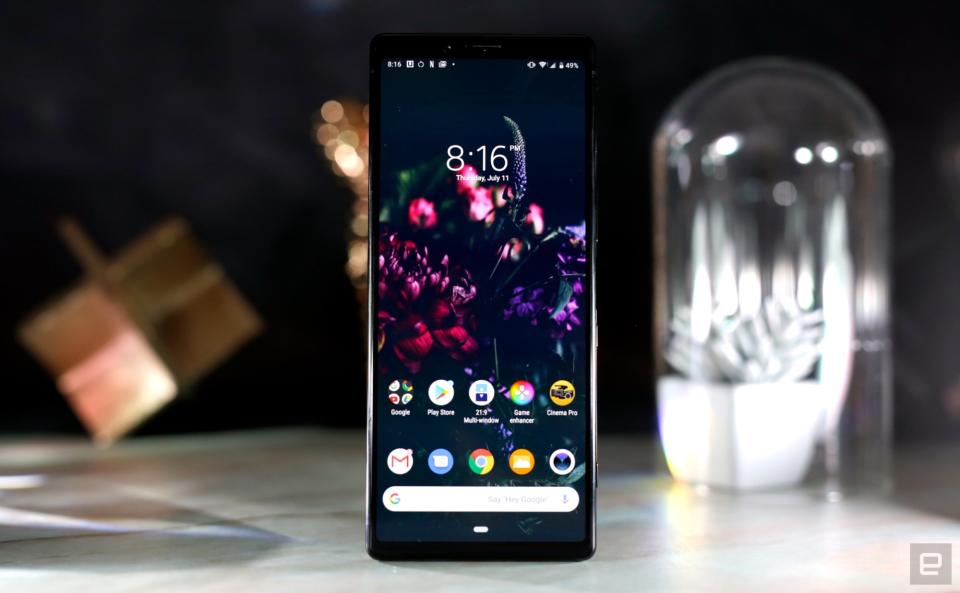
Hardware and display
Any discussion of the Xperia 1 has to start with its design. It's easily one of the most polarizing phones I've tested in a long time. That's all due to Sony's choice of display: It's a 6.5-inch panel with a longer-than-usual 21:9 aspect ratio. As a result, the Xperia 1 looks more like a remote control than a smartphone, and that resemblance quickly turned off most of the people I showed the phone to. Me? I don't mind it so much, particularly because that tall, narrow design means the Xperia 1 is surprisingly comfortable to grip. Even now, and as strange as it might sound, I find myself gravitating toward the X1 because it's easy to hold for long periods of time. Yes, you'll probably need two hands to use it effectively -- you just have to know that going into things.
Of course, how palatable this tall screen really is depends on what you want to use it for. I spend a lot of time reading on my phone, and slightly wider displays make for longer, more visually pleasant lines of text. The Xperia 1, with its narrow screen, feels less than ideal for me. No, this a phone meant for watching stuff. And how pleasant that experience is all boils down to how easily you can find cinematic, 21:9 content to binge on.
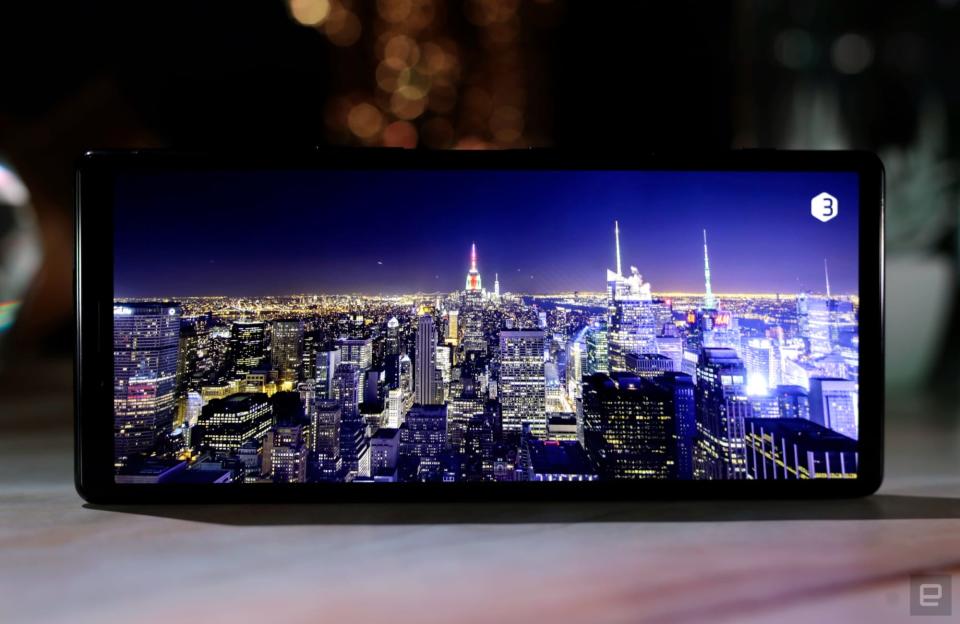
Movies will be your best bet here, and Netflix's support for ultra-wide displays means the service gets along great with the Xperia 1. Watching the right kind of videos makes for what might be the most immersive experience you'll find on a smartphone right now. Though, unless you're talking about devices with big, fold-open screens, the phrase "immersive smartphone" still seems pretty oxymoronic.
What's more, a lot of the stuff you'll run into on a daily basis won't look quite as good on this screen. Watching standard 16:9 widescreen clips on YouTube leaves you with big, black bars on either side of the display, and 4:3 video? Forget about it; there's nearly as much dead space as there is action on-screen. It just looks silly. (At least you'll have plenty of room to rest your thumbs.)
Ultimately, I can understand why Sony went with a screen like this. Ultra-wide content is becoming more readily available, and the Xperia 1 is a joy to watch that stuff on. Other smartphone makers have latched on to this more cinematic trend, too. To me at least, It's the display's 4K resolution that seems less sensible. Sony is the only company, so far, to have bothered squeezing a display that pixel-dense into a device this small, and it really went overboard by making it an HDR OLED panel. For those keeping track, that's a smartphone first.
And what can I say? It's beautiful — it doesn't hurt that there's a bevy of screen-tuning settings to get everything looking just the way you want it. Case in point: Right out of the box, the screen was set to look cooler and more neutral than I generally prefer. After jumping into the settings, I found I could very easily dial up the color temperature to something a bit more palatable. If sheer accuracy is more your thing, the built-in Creator Mode does its best to emulate the neutral tones of a reference monitor. Point is, you've got options.

Here's the rub, though: Full 4K resolution on a smartphone is sort of pointless. Yes, high-res HDR video looks amazing here. But does it look dramatically better than the same video running on one of Sony's non-4K, 21:9 screens? I don't think so. Unless you're the type who watches videos with your phone pressed up against your face, the benefits of a super-high-res display are mostly negligible.
For a phone so heavily geared toward media consumption, I also find it puzzling that its speaker setup sounds so disappointing. Audio playback wasn't nearly as loud as other phones, and there's a distinct lack of bass that'll keep your music and videos sounding thinner and less satisfying. If there were ever a smartphone that demanded a standard headphone jack, this is it. No dice, though. This might just be Sony's review units being kind of weird, but my Xperia 1 came with a pair of wired headphones terminating in a 3.5mm plug. Guess what the phone doesn't have? A 3.5mm headphone jack. And to make matters worse, there wasn't even a USB-C adapter for the headset in the box.
And then there's that vibration motor I mentioned earlier. Long story short, it's supposed to respond to prominent lows in your audio and rumble at the right times. Sony crafted it for an earlier smartphone and talked up how immersive it could make movies and games feel. But it's one of those ideas that seems unnecessary on paper and fares even worse in practice. Strictly speaking, there's nothing wrong with it — it does exactly what Sony wanted it to. But having the equivalent of an N64 Rumble Pak built into my phone doesn't make my life any better.
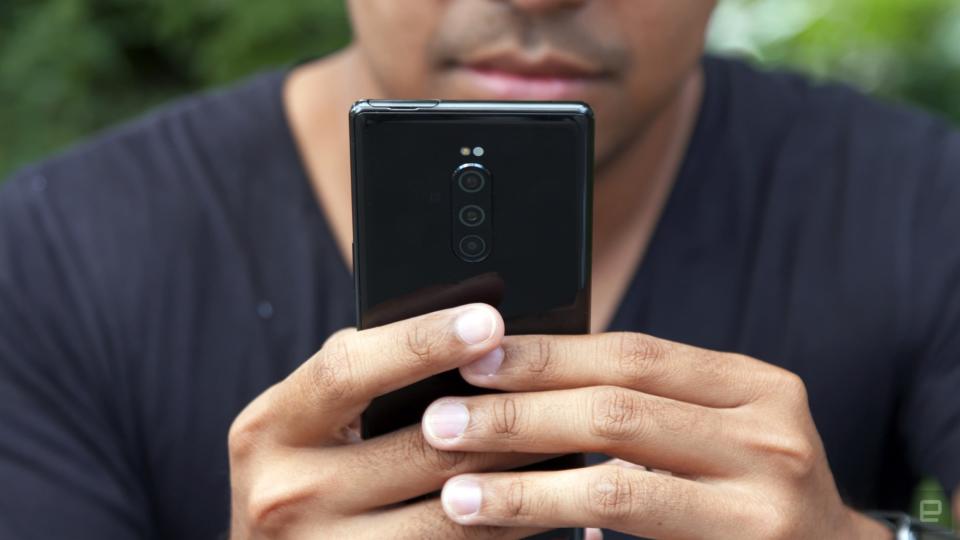
Thankfully, Sony at least put together a sturdy, lightweight body to appreciate. The phone's frame is made of metal and joins near-seamlessly to the two slightly rounded Gorilla Glass 6 panes on the front and back. It's a good thing Sony went with that durable glass here, too — as sleek and as well-put-together the Xperia 1 is, it's easily one of the most slippery phones I've used this year (only Apple's iPhones skitter to the floor with more regularity). So far, though, the Xperia's body still looks impeccable. Just be warned that this phone seems particularly well-suited to righties. All of the buttons (including the dedicated camera key) run along the Xperia's right edge. The fingerprint sensor lives there, too, placed just so it's difficult to reach with my left index finger.
The Xperia 1's sleek, slim design does have one big drawback: There's little room left for a battery. Bear in mind, this phone has to push more pixels around than any other on the market right now, so it's little surprise that the 3,330mAh battery here doesn't impress. I've been averaging between three and four hours of screen-on time — that's on the lower end of what feels acceptable for a phone this expensive. Expect about a single day's use out of the Xperia 1, if that.
In use
As objectively weird as the Xperia 1 is in some ways, the stuff that actually makes it run are all too common. Inside this sleek frame, you'll find a Snapdragon 855 chipset with 6GB of RAM and 128GB of internal storage (though you can expand that with microSD cards as large as 512GB). If that sounds familiar, well, you've been paying attention — most other premium smartphones released this year have used a similar configuration, and as a result, they're all similarly fast.
Admittedly, I wondered going into this whether the Xperia 1 could struggle in driving such a high-resolution display. Nope! I've personally never noticed any stuttering or lag while playing games and whipping through apps. Sure, your experience might vary a bit, but we've already reached the point where a) Qualcomm has a near-monopoly on high-end smartphone chipsets and b) they're fast enough to handle just about everyone's daily routines. The surprisingly clean build of Android 9 Pie certainly helps, too. Sony used to really go heavy with its skins, but it gave the Xperia 1 a cleaner, more focused vibe.
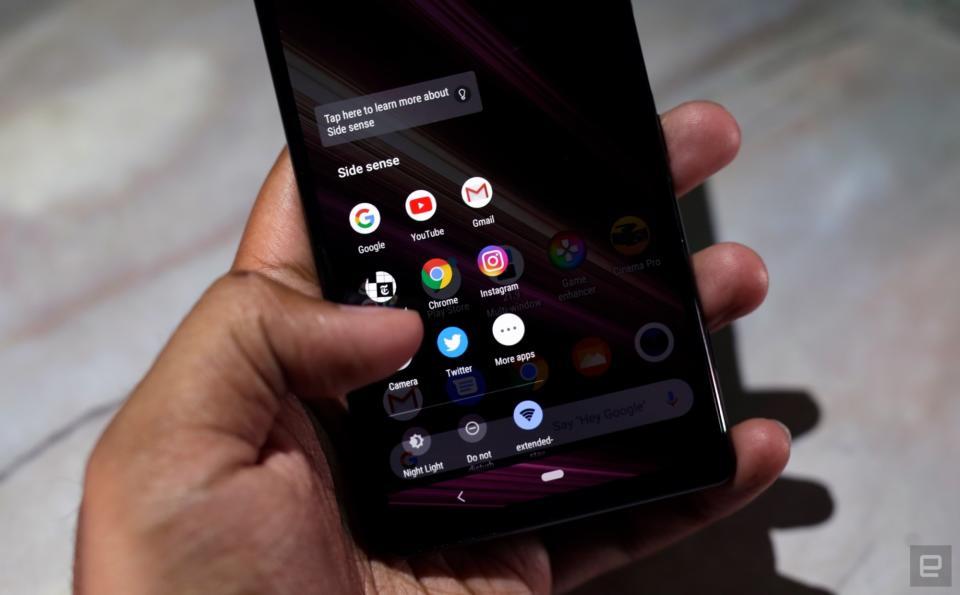
More interesting are the features here that make this big screen more useful and usable. Split-screen multitasking has been part of core Android for years now, but the Xperia 1's extra-tall screen means it's far more satisfying than on other devices. Once set up, each app displays in nearly-square windows that, combined with the screen's high resolution, mean your software looks more legible and has more space to breathe.
There's also a one-handed mode that, once enabled, shrinks the on-screen action when you double-tap the home button. I'm really not sure why it isn't on by default — it can be helpful for reaching the notifications shade sometimes, and you can resize until it feels just right. That said, if your hands are small enough that you'd need to use one-handed mode frequently, do yourself a favor and just buy a smaller phone.
Side Sense, meanwhile, strives to make it easier to access important apps and settings without having to stretch your hand across the screen. You can even set it up so that swipes on the side of the screen performs useful tasks, like opening and closing the notifications shade. It's a great idea in theory because it should negate the need to use the Xperia 1 with two hands, but it really doesn't. Most times I've activated Side Sense have been a total accident — I've even pulled the phone out of my pocket to discover that handy side window has apparently opened by itself. And when I have specifically tried to use it, it's very difficult to activate. You're supposed to double-tap the edge of the phone where the display meets the rest of the body, but finding the sweet spot takes far more practice than it should. Side Sense was supposed to make using the Xperia easier, but instead, it's just more frustrating.

And then there are the cameras. When Sony talked up the Xperia 1 earlier this year, it talked a big game — this would be a phone that benefited from all the different kinds of hardware expertise inside the company. That was especially said to be true of the X1's cameras, which packs a handful of features derived from Sony's work on its Alpha line and its professional-grade video cameras.
We're working with a 12-megapixel main camera with an f/1.6 aperture here, along with a 12-megapixel, 2x zoom with an f/2.4 aperture and an ultra-wide camera that captures a 137-degree field of view at a resolution of 12 megapixels. Sony's smartphone camera sensors are essentially the industry standard at this point, so it's probably no surprise that each of these cameras is capable of taking some pretty impressive, detailed photos.
Sony's intelligent Auto mode is generally helpful, too. As the name sort of implies, it uses AI to analyze the scene and tune its output appropriately — it's enough to add some extra life to flowers and landscapes, and it usually does a great job making sure backlit subjects don't languish in the dark. Let's be clear: The sensors are good enough to produce sharp, handsome photos on their own, though colors can sometimes appear a little muted compared to other phones. Overall, though, Sony's AI-powered improvements can be a big help.
That's not to say Sony's work here is perfect, though. The exposure of a particular scene can vary pretty wildly, especially when you're switching between those three cameras. The standard sensor tends to skew dark, while the 2x zoom camera tends to overexpose scenes without any provocation. And that wide camera? Well, it provides plenty of extra visual context, but it's set by default to maximize image quality instead of fixing the inherent fish-eye distortion. That was a specific decision to make sure those ultra-wide photos could capture as much of the space in front of it as possible, but most regular smartphone users will probably go hunting for that setting pretty quick.
Beyond all that, Sony's camera interface still needs a lot of polish. It's not that it's overly complex — it's more that it's sort of laid out with no regard for how people actually use a camera. And beyond that, the camera tends to require a bit more work and time to produce the best results. Let's you're shooting a photo and want to make sure your subject is pin-sharp. You'll be in for a bit of a wait because switching focus between planes takes awhile. There's also an automatic-capture mode turned on by default, under which the camera snaps photos on its own when it thinks you've framed up something pretty. Unlike Side Sense, this isn't just a good idea in theory — it actually has captured a few photos that I wish I'd shot myself. My only concern is that there wasn't much notice before the feature kicked in, so it felt like my camera had taken on a life of its own.
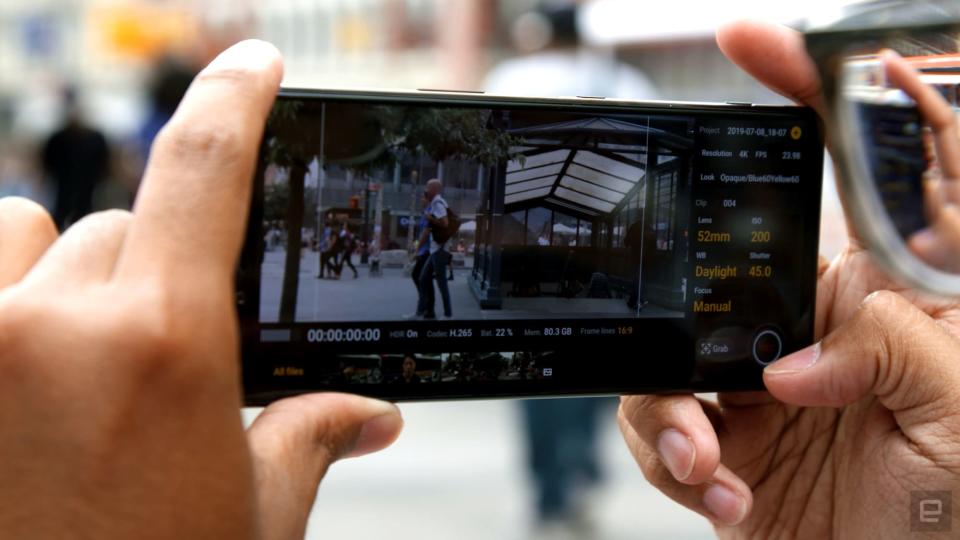
With all that said, shooting video with the built-in Cinema Pro app is pretty great. Bear in mind, I am absolutely not a video person or a cinematographer, so I'm sure some of the nuance here is lost on me. Still, the app offers plenty of depth for people who know what they're doing — you've got options to change which camera you're using, tweak the ISO and shutter, plus manually focus on your subject. (Focus-peaking would be nice to help you figure out when your subject is pin-sharp, but I guess we can't have it all.) You can even replicate certain cinematic looks, which is an especially nice touch for wannabe filmmakers. People itching to make truly cinematic videos with their smartphones will probably still be better served by investing in third-party software, Cinema Pro seems like a great way to get impressive results without too much fussing.
Wrap-up
At the end of it all, the Xperia 1 is a powerful device, and I have to give Sony credit for bucking just about every smartphone trend out there to build something truly unique. But that uniqueness comes at a cost: Between its oddball screen and some puzzling decisions, this just isn't a sensible purchase for most people. We're all spoiled for choice when it comes to expensive flagship devices, and while the Xperia 1 definitely has its charms, they don't quite make sense for the masses.
This is a niche gadget, through and through — if you're the kind of person who loves watching and making movies, you'll probably find something to appreciate here. Everyone else can move along with the knowledge that Sony is still around, plugging away and making ambitious devices. Who knows? Maybe the company's next flagship is the one to make me change my mind.

